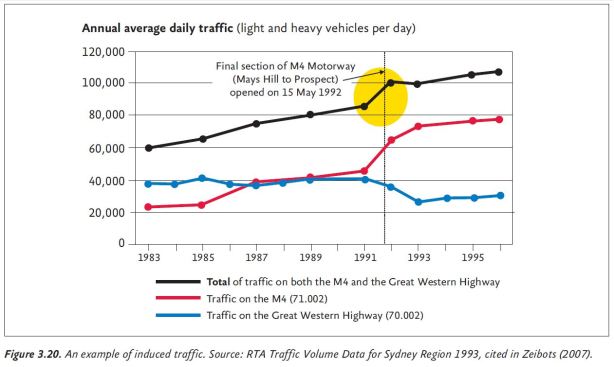The recent Infrastructure NSW report correctly states that 93% of motorised transport is on roads (page 77), and concludes from this that funding should go primarily to roads (it includes buses in the 93%, as they travel on roads). Yet another way of looking at it is to look at the share of trips by cars (both drivers and passengers) of total trips, and in that case only 68% of trips are by private car, the remainder being mostly 11% on public transport (buses and trains) and 18% walking (Source: 2010/11 Household Travel Survey). A better way of measuring the relative importance is to look at the total distance by mode, in which case cars represent 79% of total passenger km, while public transport is 16% of passenger km.
The reason this is important is that Infrastructure NSW argues that roads do the main heavy lifting, and so deserve the bulk of the funding. Yet by doing so it perpetuates the dominance of the car over public transport, something which is unsustainable from both an environmental and economic point of view given the direction in which oil prices are headed in coming decades. Quentin Dempster’s interview with the CEO of Infrastructure NSW, Paul Broad, on 7.30 NSW highlights this perfectly:
Dempster: You’ve surrendered to our dependency on the car. There’s no attempt by Infrastructure NSW to facilitate a paradigm shift to double public transport usage to decongest this city.
Broad: 93% of movements are on roads today. I don’t see that changing a lot given the nature of our city.
Dempster: You’re not even going to try to change it.
Broad: And secondly, I’ll make the point, I’ll make the point we’re very pro-buses. As many people get on a bus, which runs on a road, as get on a train. Buses are a very effective means of public transport, often the poor relation to much of the public transport debate.
Mr Broad’s report does support buses, but buses cannot handle the sorts of capacities that rail can, particularly over longer distances. That’s why the total passenger km for rail in Sydney is over double what it is for buses, despite the number of trips for buses and trains being about the same. This is because the average train trip is 16.7km, while the average bus trip is only 6.7km, so to compare just the number of trips does not show the full load carried by each mode.
In addition, transport is something where building supply creates its own demand. By building more roads, it also builds demand for them. This is illustrated by the graph below taken from the Herald Independent Transport Inquiry, which shows how the completion of the M4 between Mays Hill and Prospect created what’s known as induced demand – demand for driving that was not previously there.
The Infrastructure NSW report provides the counter argument (page 80-81) that new roads are in fact needed to keep up with growing demand, and that building these new roads is merely unlocking that demand which was already there, but being held back by congestion and slow travel speeds. They are not, it argues, designed to reduce congestion or increase speeds. But given the higher capacity of public transport, a better way of providing this additional capacity would be to entice a modal switch from car to public transport, thus freeing up existing capacity.
Nor is it guaranteed that demand for roads will continue to grow. Infrastructure NSW points out that it is currently forecast that 4 million additional trips per year will be made in 2031 compared to 2011 (age 81). Of these, 73% are from cars (drivers and passengers) while 7% are from trains and 3% from buses. It uses these figures to argue that a Second Harbour Crossing is not needed, and so should not be built.
However, looking at number of km travelled, rather than trips, then the proportion by cars drops to 64% of the increase, while public transport’s share of the increase jumps from 10% to one 32%. Not only that, but these assume that no Second Harbour Crossing will be built! Infrastructure NSW is therefore merely peddling a self fulfilling prophecy.
Despite this, the government’s marquee road project: the West Connex, is on balance a good idea. It has been designed in a way that minimises the cost (by using a slot rather than a tunnel for the M4 East), while maximising the contributions to the project’s cost (through the collection of tolls and potentially value capture of the increase in land values along the corridor). As a result, the road can be constructed with an estimated $2.5bn contribution by the government, despite the $10bn price tag. It also provides capacity for the sort of trips which are best made by cars: to non-activity centre destinations (West Connex does not connect up directly to the CBD and parking spaces there will remain unchanged, so car drivers will not be encouraged to drive in) and off-peak trips (both the M4 and M5 remain congested during the off-peak hours, as well as peak).
The real problem with West Connex is if the government is forced to take on the traffic risk, away from the private sector. If this is the case, and traffic volumes are not as high as predicted, then the cost to the government will blow out beyond $2.5bn, and put other projects at risk, particularly public transport projects.
